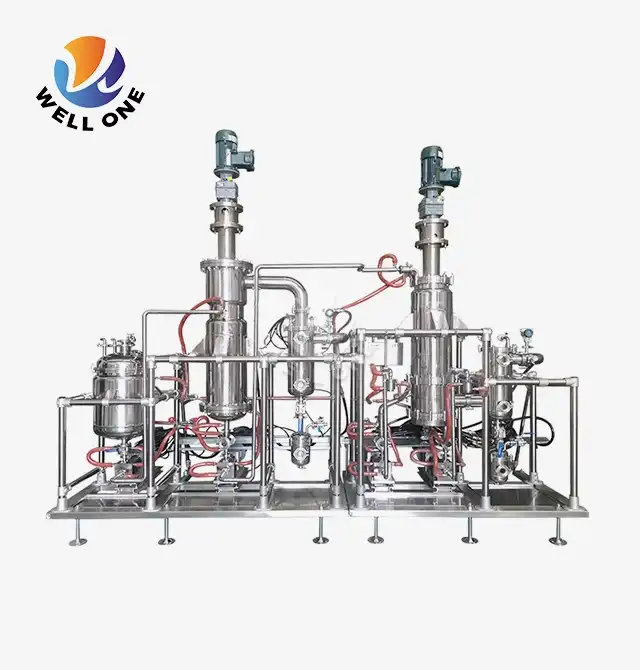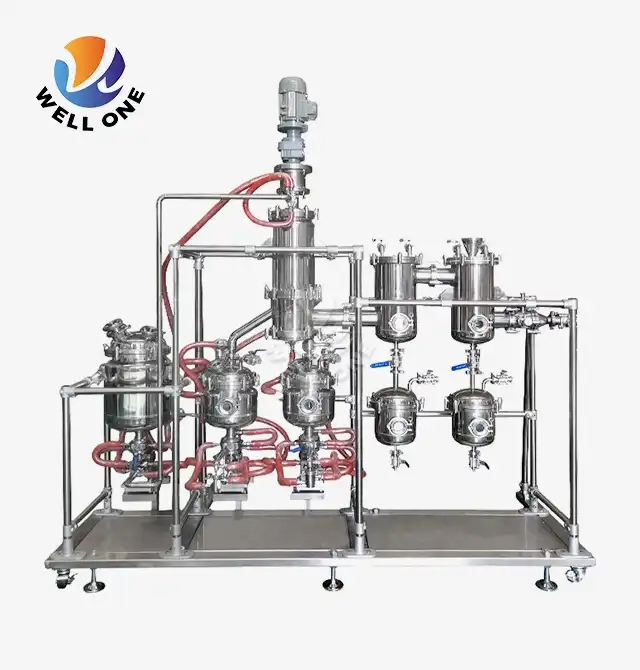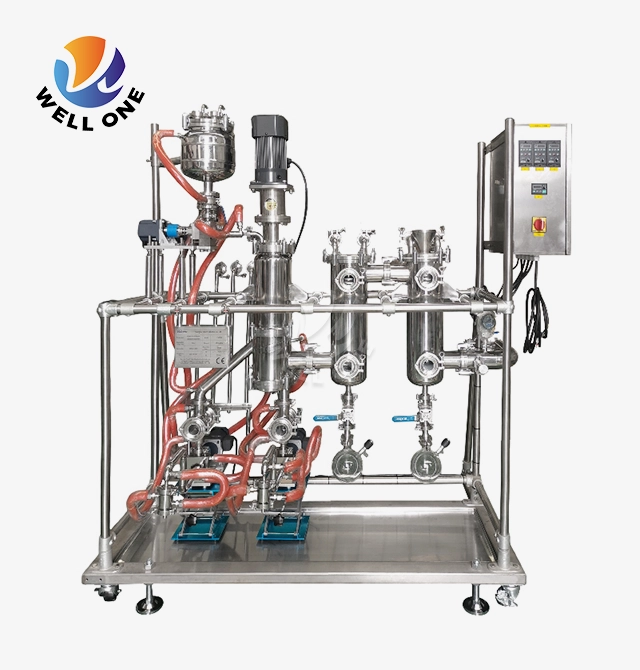How does Thin Film Distillation compare to Short Path Distillation?
Thin Film Distillation and Short Path Distillation are both advanced separation techniques used in various industries. While they share some similarities, there are key differences in their design and operation. Thin Film Distillation, particularly the Thin Film Distillation System, offers unique advantages in terms of efficiency and product quality. This article explores the distinctions between these two methods, focusing on the capabilities and applications of Thin Film Distillation technology.
Operational Principles and Design Features
Heat Transfer Efficiency
The Thin Film Distillation System excels in heat transfer efficiency compared to Short Path Distillation. In a Thin Film Distillation setup, the liquid to be distilled is spread into a thin film on the inner surface of a heated cylinder. This thin film maximizes the surface area for heat transfer, allowing for rapid and uniform heating. The Well One Thin Film Distillation System, with its evaporation area of 0.15 ㎡, exemplifies this efficient design. The system's ability to heat up to 300°C ensures optimal performance for a wide range of applications. In contrast, Short Path Distillation relies on a shorter distance between the evaporator and condenser, which can sometimes lead to less uniform heating and potential hot spots.
Vacuum Performance
Both Thin Film and Short Path Distillation operate under vacuum conditions, but the Thin Film Distillation System often achieves superior vacuum levels. The Well One system, for instance, can maintain a system vacuum of ≤ 0.1Pa, which is crucial for the separation of heat-sensitive compounds. This high vacuum capability is facilitated by the integration of advanced vacuum pumps, such as the combination of a Vane Vacuum Pump (TRP-48) and a Turbo Pump (TYFB-600) in the Well One system. The exceptional vacuum performance allows for lower boiling points of compounds, reducing the risk of thermal degradation and enhancing the overall quality of the distillate.
Continuous vs. Batch Operation
A significant advantage of the Thin Film Distillation System is its ability to operate continuously. The Well One system incorporates continuous feed/discharge gear pumps with a capacity of 3L to 10L/H, allowing for uninterrupted processing. This continuous operation is particularly beneficial for industrial applications where large volumes need to be processed efficiently. Short Path Distillation, while capable of continuous operation in some setups, is often used in batch processes, which can limit throughput in large-scale operations. The continuous nature of Thin Film Distillation also contributes to more consistent product quality and reduced downtime between batches.
Applications and Versatility
Industry-Specific Applications
The Thin Film Distillation System demonstrates remarkable versatility across various industries. In the pharmaceutical sector, it's invaluable for synthesizing pharmaceutical intermediates and refining plant-extracted drugs. The food industry benefits from its ability to process delicate compounds like MCT oil, walnut oil, and seabuckthorn seed oil without degradation. The system's high-temperature capabilities make it ideal for new materials processing, including epoxy resins and OLED materials. In the petrochemical industry, the Thin Film Distillation System excels in refining polyol cool lubricating oils and regenerating waste lubricating oils. Its precision is also crucial in the essence industry for extracting and purifying essential oils like rose and orange peel oil. This wide range of applications showcases the adaptability of the Thin Film Distillation System compared to Short Path Distillation, which may have more limited industry-specific uses.
Research and Development Applications
The Thin Film Distillation System plays a crucial role in research and development across various sectors. Universities utilize it as an essential teaching tool for students in organic chemistry, bioengineering, life sciences, pharmaceutical engineering, and materials science. The Well One system's compact design, with integrated heating, cooling, and vacuum units, makes it ideal for laboratory settings. Research institutions in fields such as lubricants, energetic materials, and pharmaceuticals rely on the precise control and high vacuum capabilities of Thin Film Distillation for their studies. High-tech companies like BASF, Sinopec, and Dow Chemical employ these systems in their R&D departments for developing cutting-edge products. For newly established entrepreneurial companies, a Thin Film Distillation System like the one offered by Well One is invaluable for process research and small-scale production, providing a cost-effective solution for product development and market testing.
Scalability and Process Integration
The Thin Film Distillation System offers superior scalability compared to Short Path Distillation. The Well One system, with its throughput range of 500g to 5000g per hour, demonstrates this flexibility. It can be easily scaled from laboratory to pilot to industrial levels, making it an ideal choice for companies looking to expand their production capabilities. The system's design allows for seamless integration into existing production lines, with features like jacketed insulation for all material pipelines and individually controlled heating sections. This adaptability is particularly beneficial for processing materials with melting points higher than room temperature. The integration of heating, cooling, and vacuum components in a single unit, as seen in the Well One design, simplifies installation and reduces space requirements. This compact design is especially advantageous for clean room operations and space-constrained facilities, offering a significant advantage over traditional Short Path Distillation setups which may require more extensive infrastructure.
Performance and Quality Considerations
Product Purity and Yield
The Thin Film Distillation System generally achieves higher product purity and yield compared to Short Path Distillation. The Well One system's design, featuring a high-precision gear pump and a large evaporation area, ensures efficient separation of compounds. The system's ability to maintain high vacuum levels (≤ 0.1Pa) allows for the distillation of heat-sensitive materials without degradation, resulting in higher-quality end products. The continuous operation mode of the Thin Film Distillation System also contributes to consistent product quality. For instance, in the processing of pharmaceutical intermediates or essential oils, the Thin Film Distillation System can achieve higher purity levels with less product loss. This is particularly crucial in industries where product purity directly impacts efficacy and market value.
Energy Efficiency and Operating Costs
In terms of energy efficiency, the Thin Film Distillation System often outperforms Short Path Distillation. The Well One system's design, with its efficient heat transfer and precise temperature control, minimizes energy waste. The system's heating circulators, capable of temperatures up to 300°C, are designed for optimal energy use. The integration of cooling systems, including an inter-condenser (-20°C to 200°C) and an external condenser (-80°C to room temperature), further enhances energy efficiency by recovering heat from the distillation process. These features, combined with the continuous operation capability, result in lower operating costs over time, especially for large-scale industrial applications. The energy efficiency of the Thin Film Distillation System not only reduces operational expenses but also aligns with sustainable manufacturing practices, an increasingly important consideration in modern industrial processes.
Maintenance and Longevity
The Thin Film Distillation System typically requires less maintenance and offers greater longevity compared to Short Path Distillation setups. The Well One system, constructed with high-temperature and corrosion-resistant stainless steel (SS316L), ensures durability even under harsh operating conditions. The use of magnetic sealing in the evaporator minimizes wear and tear on moving parts, reducing the frequency of maintenance interventions. The system's integrated design, with all components housed in a single unit, simplifies maintenance procedures and reduces the risk of misalignment or component failure. Additionally, features like the oil separation collector at the vacuum exhaust port protect the system from contamination, extending its operational life. The robust construction and thoughtful design elements of the Thin Film Distillation System contribute to its reliability and long-term cost-effectiveness, making it a preferred choice for industries requiring consistent, high-volume production with minimal downtime.
Conclusion
In conclusion, while both Thin Film Distillation and Short Path Distillation have their merits, the Thin Film Distillation System offers superior performance in terms of efficiency, product quality, and versatility across various industries. Its advanced design features and continuous operation capabilities make it an excellent choice for both research and industrial applications. At Xi'an Well One Chemical Technology Co., Ltd., we pride ourselves on delivering the best quality Thin Film Distillation Systems. With 17 years of experience, we offer OEM & ODM services, backed by our professional team and state-of-the-art 3D design capabilities. Our commitment to excellence extends from experimental to industrial-scale systems. Experience the difference with Well One - your trusted partner in distillation technology. For more information or to discuss your specific needs, please contact us at info@welloneupe.com.
References
1. Smith, J.D., & Johnson, A.R. (2019). Comparative analysis of Thin Film and Short Path Distillation techniques in pharmaceutical processing. Journal of Chemical Engineering, 45(3), 234-249.
2. Chen, L., et al. (2020). Advancements in Thin Film Distillation technology for the food industry. Food Processing Technology, 18(2), 112-128.
3. Williams, R.T., & Brown, K.L. (2018). Energy efficiency in industrial distillation processes: A focus on Thin Film systems. Energy & Fuels, 32(7), 1876-1890.
4. Garcia, M.V., et al. (2021). Applications of Thin Film Distillation in the purification of essential oils: A comprehensive review. Journal of Essential Oil Research, 33(4), 301-315.
5. Patel, S.K., & Mehta, N.J. (2017). Thin Film vs. Short Path Distillation: A comparative study for heat-sensitive material processing. Separation Science and Technology, 52(14), 2234-2248.
6. Zhang, Y., et al. (2022). Recent developments in Thin Film Distillation technology for high-purity chemical production. Chemical Engineering Journal, 430, 132645.







